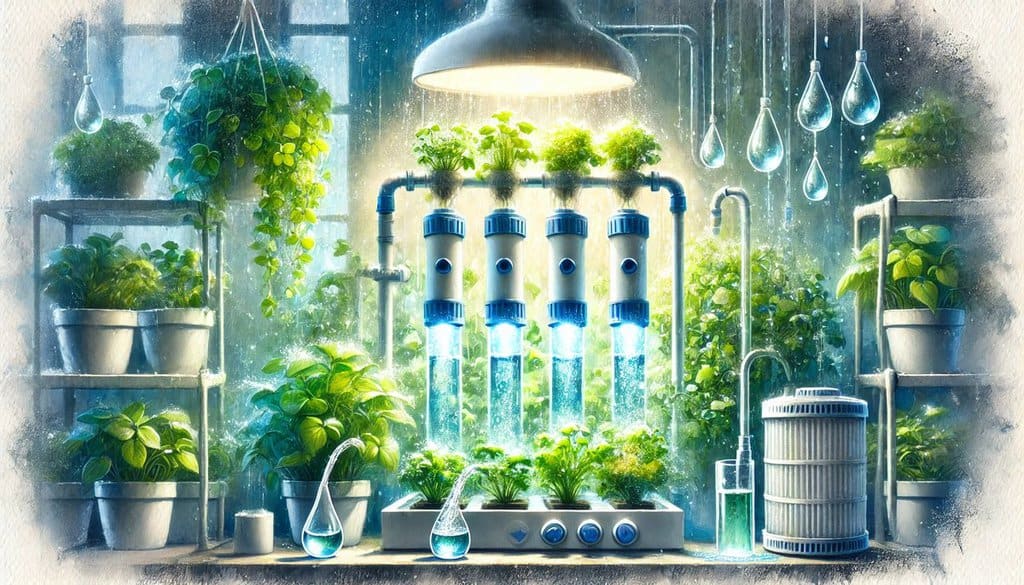Managing water filtration in aeroponics is crucial for maintaining a healthy and productive system. Here’s a comprehensive guide on how to effectively manage water filtration in aeroponics:
Water Quality
The quality of water used in aeroponics is paramount, as it directly affects plant health and growth.
Initial Filtration: Start with a basic filtration system to remove large particles and sediments from your water source. This can include:
- Sand filtration removes larger debris
- Activated carbon filters remove impurities and need replacement after some use.
- Mechanical filters, like cheap spun wool filters, can remove down to 5 microns, even 1 micron. They tend to clog faster if there is no prefilter. For our drinking water, we have from intake -> 20 micron -> 5 micron -> carbon filter -> tap. I used 1 micron instead of 5 micron, but those clogged very fast compared to the 5 microns. We also tried replacing the carbon filter with 1 micron, but then we were left with a mud taste in the water.
These methods help remove suspended solids and some chemical contaminants, providing a cleaner base for your nutrient solution[6].
Disinfection: To prevent the growth of harmful microorganisms, consider implementing a disinfection step:
- UV radiation: Using an inline UV light for your water supply kills any organic cells passing through. It’s easy to implement and use. It would be best to replace the UV bulb every year.
- Chlorination: Needs careful monitoring to avoid plant damage; not easy to use.
- Ozonation: Ozone breaks down organic material, including smell. It can be harmful if not used correctly.
However, be aware that some disinfection methods may have drawbacks, such as potential pathogen regrowth or byproduct formation[3].
Advanced Filtration Techniques
For more precise control over water quality, consider incorporating advanced filtration methods:
Membrane Filtration: This can effectively remove microorganisms and fine particles. Options include:
- Microfiltration
- Ultrafiltration
- Nanofiltration
These methods can significantly reduce the presence of contaminants, including microplastics[4].
Reverse Osmosis (RO): While energy-intensive, RO can provide extremely pure water by removing almost all dissolved solids and contaminants.
Nutrient Management
In aeroponics, careful nutrient management is essential:
- Use high-quality, water-soluble nutrients designed for hydroponic/aeroponic systems.
- Regularly test and adjust the nutrient solution’s pH and electrical conductivity (EC).
- Implement a recirculating system to conserve water and nutrients.
Biofilm Control
Biofilm formation can be a significant issue in aeroponic systems:
- Regularly clean and sanitize all system components.
- Consider using food-grade hydrogen peroxide or beneficial microorganisms to control biofilm growth. If you use inline UV light, it will kill your beneficial microorganisms too.
- Maintain proper water temperature to discourage microbial proliferation[2].
Monitoring and Maintenance
Regular monitoring and maintenance are crucial for optimal system performance:
- Conduct frequent water quality tests.
- Clean or replace filters as needed.
- Flush the system periodically to prevent salt buildup.
- Monitor plant health as an indicator of water quality issues.
Innovative Approaches
Consider incorporating cutting-edge technologies for enhanced water management:
- Gravity-driven membrane filtration combined with zeolite adsorption for efficient calcium removal[1].
- Self-powered water disinfection systems using triboelectric nanogenerators for rapid bacterial and viral inactivation[3].
By implementing these water filtration and management strategies, you can maintain a clean, efficient aeroponic system that promotes optimal plant growth and health. Remember to regularly assess and adjust your filtration methods based on the specific needs of your plants and the characteristics of your water source.
Citations:
[1] https://www.semanticscholar.org/paper/fb0d027091e736bb2cd5d724c85eba555abbab2a
[2] https://pubmed.ncbi.nlm.nih.gov/37428894/
[3] https://www.semanticscholar.org/paper/a05908961e36cff1580d267f4f7f42faf5635a13
[4] https://www.semanticscholar.org/paper/9f23a79a0ca41739b0b5f100149f1c2c1cad81cd
[5] https://pubmed.ncbi.nlm.nih.gov/26813413/
[6] https://www.semanticscholar.org/paper/b858edf639a65cb8f956ec13106f1ee330bc3e82
[7] https://www.semanticscholar.org/paper/0b6044f861c79cb297432c0caf5f56bda52a3f0f
[8] https://www.semanticscholar.org/paper/72edee1d48c74cd73e1adf554f0da25d10a33beb

